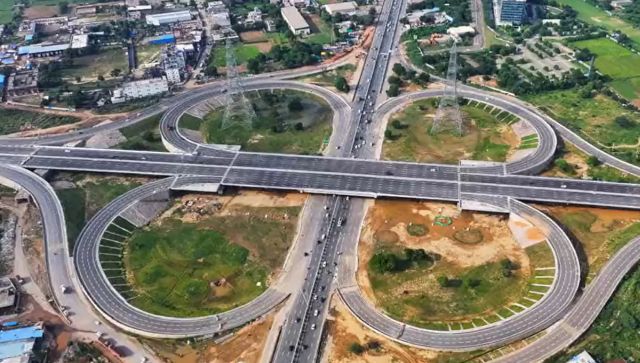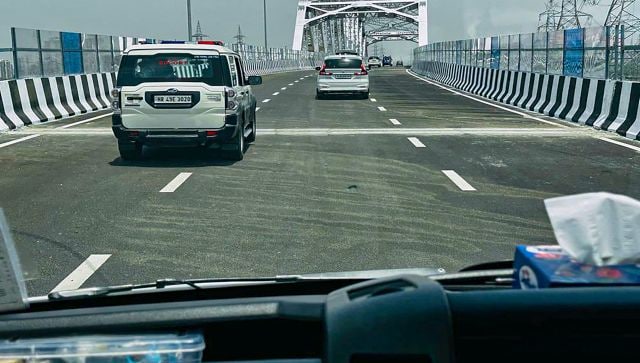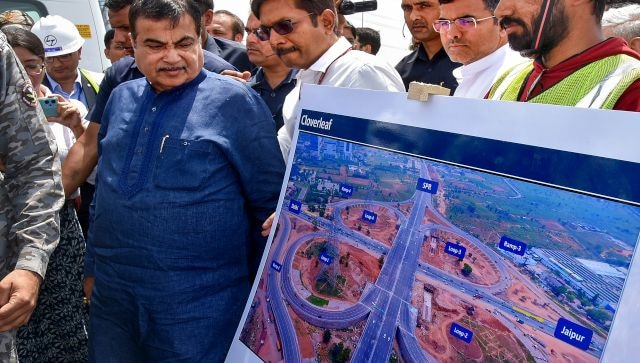All about India’s first eight-lane elevated highway

The Dwarka Expressway is expected to decongest NH-48 between Delhi and Gurugram. Image courtesy: @@nitin_gadkari/Twitter
India is seeing an infrastructure boom. Roads and highways are being added at a fast pace as the Narendra Modi-led government pushes for economic progress and the latest feather in its cap is an eight-lane elevated expressway connecting Delhi to Haryana. Called the Dwarka Expressway, this is the first of its kind motorway in the country and will be open to the public in the next three to four months.
Union Minister of Road Transport and Highways Nitin Gadkari shared a video of the upcoming road on X, formerly known as Twitter, and called it a “marvel of engineering” and a “state-of-the-art” project.
What’s so special about Dwarka Expressway?
The expressway is a four-pack motorway with a length of 563 kilometres and is expected to decongest National Highway-48 between Delhi and Gurugram. It comprises flyovers, tunnels and underpasses and spans from Shiv Murti on NH-48 to Kherki Daula Toll Plaza in Gurugram.
The Dwarka Expressway will improve connectivity between Delhi and Haryana with the travel time between Delhi to Manesar reduced to 15 minutes from the current hour and a half. According to the video shared by Gadkari, it will take 20 minutes to go from Manesar to Indira Gandhi International Airport, 25 minutes from Dwarka to the Singhu border and 45 minutes from Manesar to the Singhu border. The project will also strengthen the connectivity of the International Convention Centre in Dwarka, Sector 25.
A three-way service lane is constructed on both sides of the expressway. The project integrates an Intelligent Transport System (ITS) for advanced transportation.
The road has been constructed using two lakh tonnes of steel, which is 30 times more than what was used to build the Eiffel Tower in Paris. Moreover, 20 lakh cubic meters of cement concrete, which is six times more than what was used for Dubai’s Burj Khalifa, has been used. Twelve hundred trees were reportedly replanted during the construction.
The building of the expressway costs Rs 10,000 crore and is part of the Bharatmala Phase-I project. Rs 91,000 crore for 5,000 km was finalised for the infrastructure development under this project on 10 August 2016, reports News18.
However, the cost of construction of the Dwarka Expressway has come under the scanner of the Comptroller Auditor General of India (CAG).

What are CAG’s concerns?
The CAG has raised an alarm about the escalation of cost in the construction of the road. It tabled a report in Parliament on 10 August which pointed out that the expressway was built at a “very high cost” of Rs 250.77 crore per km. This far exceeds the Rs 18.2 crore per km approved by the Cabinet Committee on Economic Affairs.
That’s not all. According to the CAG report, the construction of the highway was approved by the road ministry without a detailed project report.
Now the report has led to a slugfest between the Centre and the Aam Aadmi Party (AAP).
What is the AAP saying?
Last week, the Aam Aadmi Party staged a protest at the under-construction expressway. Several party leaders and workers alleged that the project was a “scam” with Delhi chief minister Arvind Kejriwal saying that the Narendra Modi-led government has “broken all records of corruption”.
On Friday, the matter came up during a session of the Delhi Assembly as AAP MLAs cited CAG reports on various schemes by the Centre including the Dwarka Expressway.
Starting the discussion on the alleged scam in the construction of Dwarka Expressway and other irregularities pointed out by the CAG in its report tabled in Parliament, AAP MLA Rituraj said that the cost of the expressway increased from Rs 18 crore per km to Rs 250 crore per km.
“This seems to be a gold road,” added Rituraj and demanded the “scam” should be probed by the CBI or the Enforcement Directorate “although not much is expected from them”, reports the news agency PTI.
AAP minister Imran Hussain said that on the one hand, Prime Minister Modi talks about fighting corruption, but the CAG report has shown that agencies of the Centre are involved in irregularities. “While the Dwarka Expressway is being constructed at a cost 15 times higher than the estimated cost, the AAP government in Delhi has completed projects at costs lower than estimates and that too in time,” he claimed.

What is the Centre saying?
Gadkari has refuted allegations of “high construction cost” and said that the Dwarka Expressway was not 29 kilometres long as mentioned in the CAG report but around 230 kilometres long, as it had tunnels included in it as well, reports India Today. He said that Rs 9.5 crore was being spent per kilometre.
The minister claimed that he had spoken with CAG officials who were convinced by the explanation but still went ahead with the report.
According to government sources, in the absence of an adequate response from the road transport and highways ministry and the National Highway Authority of India (NHAI), the CAG adopted an incorrect methodology for computing the cost of the Dwarka Expressway. The CAG simply divided the total cost of construction of Rs 91,000 crore (expenditure) under the National Corridor Efficiency Programme with the project’s entire length of 5,000 kilometres under development, they claimed.
The sources said that the CAG has noted that the cost of construction of Rs 18.2 crore per kilometre does not include the cost norms for flyovers, ring roads, etc. They were of the view that the expressway has elevated roads, underpasses, tunnels and other components which were not part of the project, reports PTI.
The government has saved 12 per cent in construction costs against estimates in awarding contracts for the expressway, ministry sources claimed. They said that all four contracts for the Dwarka Expressway were put out for tender at an average civil cost of Rs 206.39 crore per kilometre. Ultimately, the contracts were awarded at a substantially reduced rate of Rs 181.94 crore per km, which reflects a 12 per cent reduction from the estimates.
With inputs from agencies

Atul Tiwari is a seasoned journalist at Mumbai Times, specializing in city news, culture, and human-interest stories. With a knack for uncovering compelling narratives, Atul brings Mumbai’s vibrant spirit to life through his writing.





